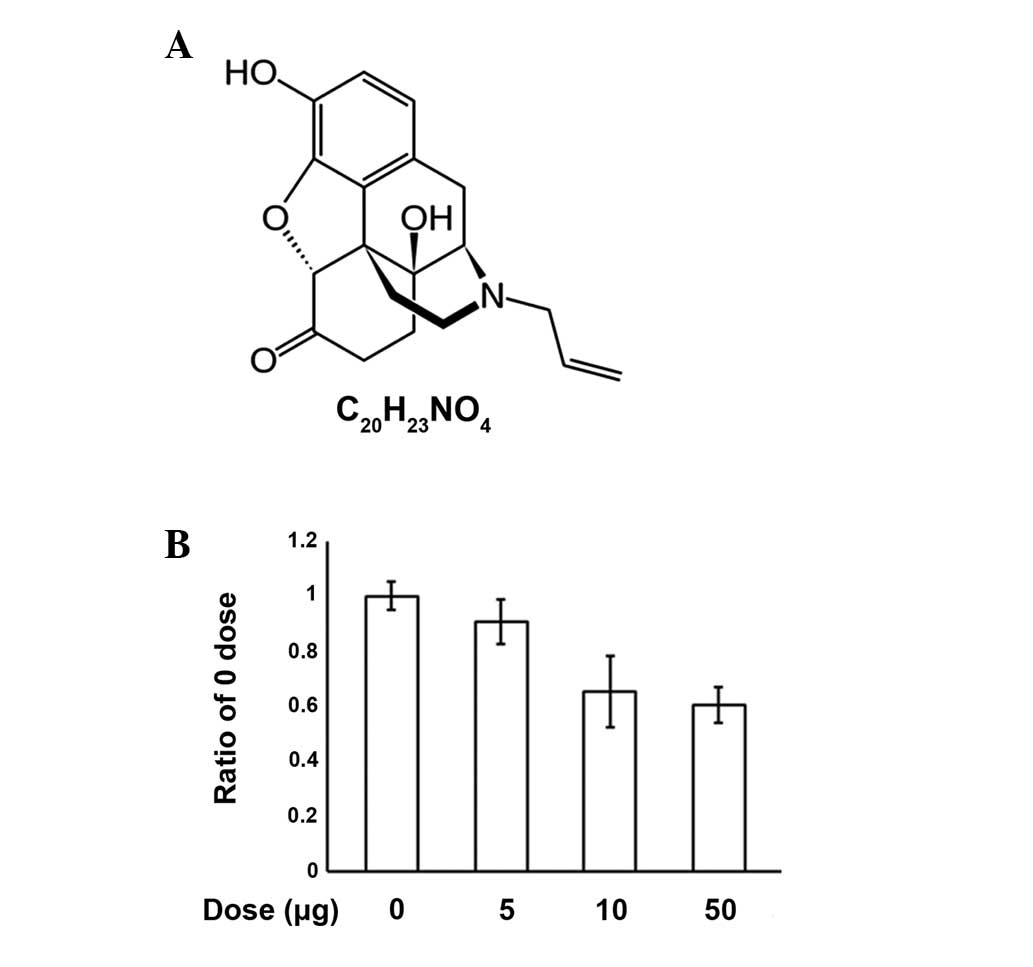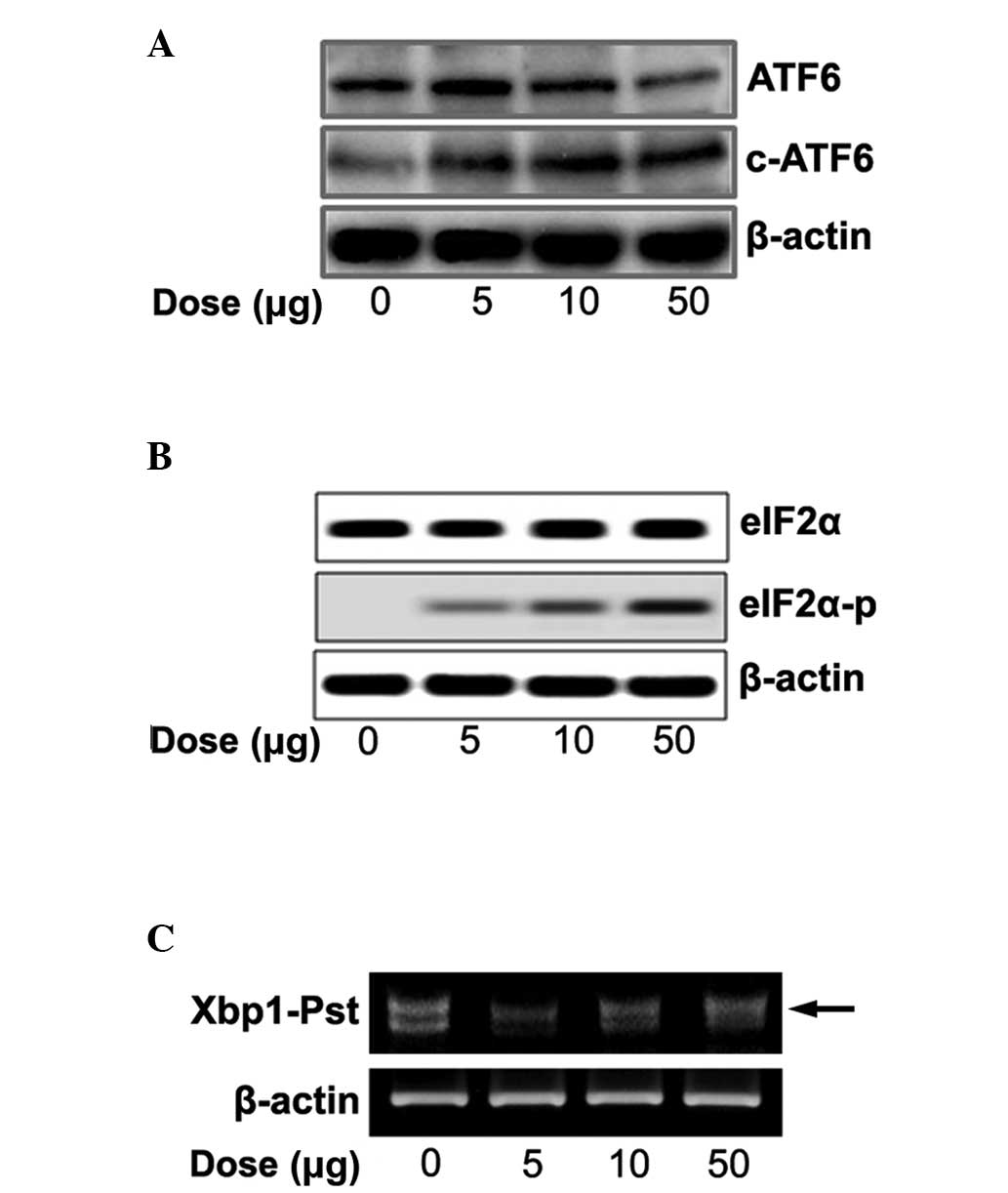Naloxone induces endoplasmic reticulum stress in PC12 cells
- Authors:
- Soyoung Seo
- Young-Sook Kwon
- Kweon Yu
- Seung-Whan Kim
- O-Yu Kwon
- Kyung-Hee Kang
- Kisang Kwon
View Affiliations
Affiliations: Inje University Busan-Paik Hospital, Busan 614-735, Republic of Korea, Department of Nursing, JoongBu University, Geumsan 312‑702, Republic of Korea, Korea Research Institute of Bioscience & Biotechnology, Daejeon 305-806, Republic of Korea, Department of Emergency Medicine, Chungnam National University Hospital, Daejeon 301-721, Republic of Korea, Department of Anatomy, College of Medicine, Chungnam National University, Daejeon 301-747, Republic of Korea, Department of Dental Hygiene, Konyang University, Daejeon 301-832, Republic of Korea, Department of Biomedical Laboratory Science, College of Health and Welfare, Kyungwoon University, Gumi 730-739, Republic of Korea
- Published online on: February 7, 2014 https://doi.org/10.3892/mmr.2014.1935
-
Pages:
1395-1399
Metrics: Total
Views: 0 (Spandidos Publications: | PMC Statistics: )
Metrics: Total PDF Downloads: 0 (Spandidos Publications: | PMC Statistics: )
This article is mentioned in:
Abstract
Naloxone is an opioid inverse agonist used in the treatment of opiate overdose, with well known pharmacology. In the present study, we determined the effects of naloxone on the unfolded protein response (UPR) in PC12 cells. Data from a 3-(4,5-dimethylthiazol-2-yl)-2,5-diphenyltetrazolium bromide (MTT) assay indicated that naloxone may accelerate PC12 cell apoptosis in a dose-dependent manner. We also demonstrated that naloxone upregulated gene expression of endoplasmic reticulum (ER) chaperones, including binding immunoglobulin protein (Bip), calnexin, ER protein 29 (ERp29) and protein disulfide isomerase (PDI), and ER stress sensors, including activating transcription factor 6 (ATF6), inositol-requiring enzyme 1 (IRE1) and protein kinase-like ER kinase (PERK). In addition, naloxone also induced typical ER stress phenomena, including ART6 proteolytic cleavage, eIF2α phosphorylation and XBP1 mRNA splicing. Furthermore, naloxone upregulated gene expression of ER chaperones and ER stress sensors in in vivo experiments. To the best of our knowledge, these results are the first to indicate that naloxone induces ER stress in vitro and in vivo.
View References
|
1
|
Ashton H and Hassan Z: Best evidence topic
report. Intranasal naloxone in suspected opioid overdose. Emerg Med
J. 23:221–223. 2006. View Article : Google Scholar : PubMed/NCBI
|
|
2
|
Handal KA, Schauben JL and Salamone FR:
Naloxone. Ann Emerg Med. 12:438–445. 1983. View Article : Google Scholar
|
|
3
|
Krizanac-Bengez L, Boranić M, Testa NG and
Kardum I: Naloxone interferes with granulocytopoiesis in long-term
cultures of mouse bone marrow; buffering by the stromal layer. Res
Exp Med (Berl). 194:375–382. 1994. View Article : Google Scholar : PubMed/NCBI
|
|
4
|
Liu SL, Li YH, Shi GY, et al: A novel
inhibitory effect of naloxone on macrophage activation and
atherosclerosis formation in mice. J Am Coll Cardiol. 48:1871–1879.
2006. View Article : Google Scholar : PubMed/NCBI
|
|
5
|
Beverley CL, Higgins PJ and Borenfreund E:
The effect of methadone and naloxone on cultured rat liver cells.
Exp Cell Biol. 52:170–175. 1984.PubMed/NCBI
|
|
6
|
Almela P, Milanés MV and Laorden ML:
Activation of the ERK signalling pathway contributes to the
adaptive changes in rat hearts during naloxone-induced morphine
withdrawal. Br J Pharmacol. 151:787–797. 2007. View Article : Google Scholar : PubMed/NCBI
|
|
7
|
Almela P, Martínez-Laorden E, Atucha NM,
et al: Naloxone-precipitated morphine withdrawal evokes
phosphorylation of heat shock protein 27 in rat heart through
extracellular signal-regulated kinase. J Mol Cell Cardiol.
51:129–139. 2011. View Article : Google Scholar
|
|
8
|
Venihaki M, Gravanis A and Margioris AN:
Opioids inhibit dopamine secretion from PC12 rat pheochromocytoma
cells in a naloxone-reversible manner. Life Sci. 58:75–82. 1996.
View Article : Google Scholar : PubMed/NCBI
|
|
9
|
Claessen JH, Kundrat L and Ploegh HL:
Protein quality control in the ER: balancing the ubiquitin
checkbook. Trends Cell Biol. 22:22–32. 2012. View Article : Google Scholar : PubMed/NCBI
|
|
10
|
Ni M and Lee AS: ER chaperones in
mammalian development and human diseases. FEBS Lett. 581:3641–3651.
2007. View Article : Google Scholar : PubMed/NCBI
|
|
11
|
Back SH and Kaufman RJ: Endoplasmic
reticulum stress and type 2 diabetes. Annu Rev Biochem. 81:767–793.
2012. View Article : Google Scholar : PubMed/NCBI
|
|
12
|
Jin W, Lee NM, Loh HH and Thayer SA:
Opioids mobilize calcium from inositol
1,4,5-trisphosphate-sensitive stores in NG108-15 cells. J Neurosci.
14:1920–1929. 1994.PubMed/NCBI
|
|
13
|
Otero JH, Lizák B and Hendershot LM: Life
and death of a BiP substrate. Semin Cell Dev Biol. 21:472–478.
2010. View Article : Google Scholar : PubMed/NCBI
|
|
14
|
Wilkinson B and Gilbert HF: Protein
disulfide isomerase. Biochim Biophys Acta. 1699:35–44. 2004.
View Article : Google Scholar : PubMed/NCBI
|
|
15
|
Zhang D and Richardson DR: Endoplasmic
reticulum protein 29 (ERp29): An emerging role in cancer. Int J
Biochem Cell Biol. 43:33–36. 2011. View Article : Google Scholar : PubMed/NCBI
|
|
16
|
Chevet E, Smirle J, Cameron PH, et al:
Calnexin phosphorylation: linking cytoplasmic signalling to
endoplasmic reticulum lumenal functions. Semin Cell Dev Biol.
21:486–490. 2010. View Article : Google Scholar : PubMed/NCBI
|
|
17
|
Lee KR, Kim SW, Kim YK, et al: Silkworm
Hemolymph Down-Regulates the Expression of Endoplasmic Reticulum
Chaperones under Radiation-Irradiation. Int J Mol Sci.
12:4456–4464. 2011. View Article : Google Scholar : PubMed/NCBI
|
|
18
|
Shore GC, Papa FR and Oakes SA: Signaling
cell death from the endoplasmic reticulum stress response. Curr
Opin Cell Biol. 23:143–149. 2011. View Article : Google Scholar : PubMed/NCBI
|













